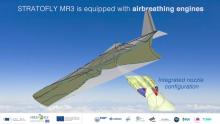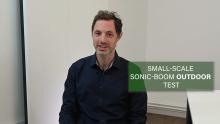Imagine an airplane fast enough to connect Europe and Australia in three hours, powered by hydrogen and flying at an altitude of over 30 kilometers: an ambitious idea, aiming to provide concrete answers to challenges such as climate change, which is making current routes increasingly complex.
This will only be possible by combining speed, safety, noise reduction, and maximum passenger comfort while minimizing environmental impact.
At Politecnico di Torino, research in the field of advanced aviation and sustainable high-speed flight is at the forefront of international innovation. PoliTO is actively engaged in two pioneering projects: STRATOFLY and More&Less.
The STRATOFLY project (Stratospheric Flying Opportunities for High-Speed Propulsion Concepts), coordinated by Politecnico di Torino, is a European initiative funded under Horizon 2020.
Its goal is to develop a concept for a hypersonic civil aircraft capable of flying at Mach 8 (around 9,800 km/h) at an altitude of 30 km, drastically reducing travel times on intercontinental routes. The project focuses on advanced propulsion and structural technologies, with a strong emphasis on environmental sustainability. STRATOFLY aims to minimize emissions and noise by using alternative fuels such as liquid hydrogen and by adopting innovative aerodynamic solutions. The aircraft is designed to operate safely and efficiently in the stratosphere, with a lower environmental impact than current aviation standards.
The project involved numerous European partners and used advanced simulation tools to analyze flight trajectories, operational modes, and off-nominal scenarios. Although full deployment of hypersonic aircraft is still a long-term goal, technological progress and international collaboration are making it increasingly feasible.
The European project More&Less explores the reintroduction of civil supersonic flight in a sustainable way. The initiative focuses on reducing sonic booms, chemical emissions, and take-off noise, proposing solutions such as alternative fuels (liquid hydrogen and SAF) and optimized flight routes and altitudes.
The project aims to provide regulators with recommendations to enable the operation of new supersonic aircraft, overcoming the environmental and regulatory barriers that ended the Concorde era. The research aligns with a global resurgence of interest in fast air travel, driven by efficiency needs, changing climate conditions and technological advances like NASA’s X-59 demonstrator.

